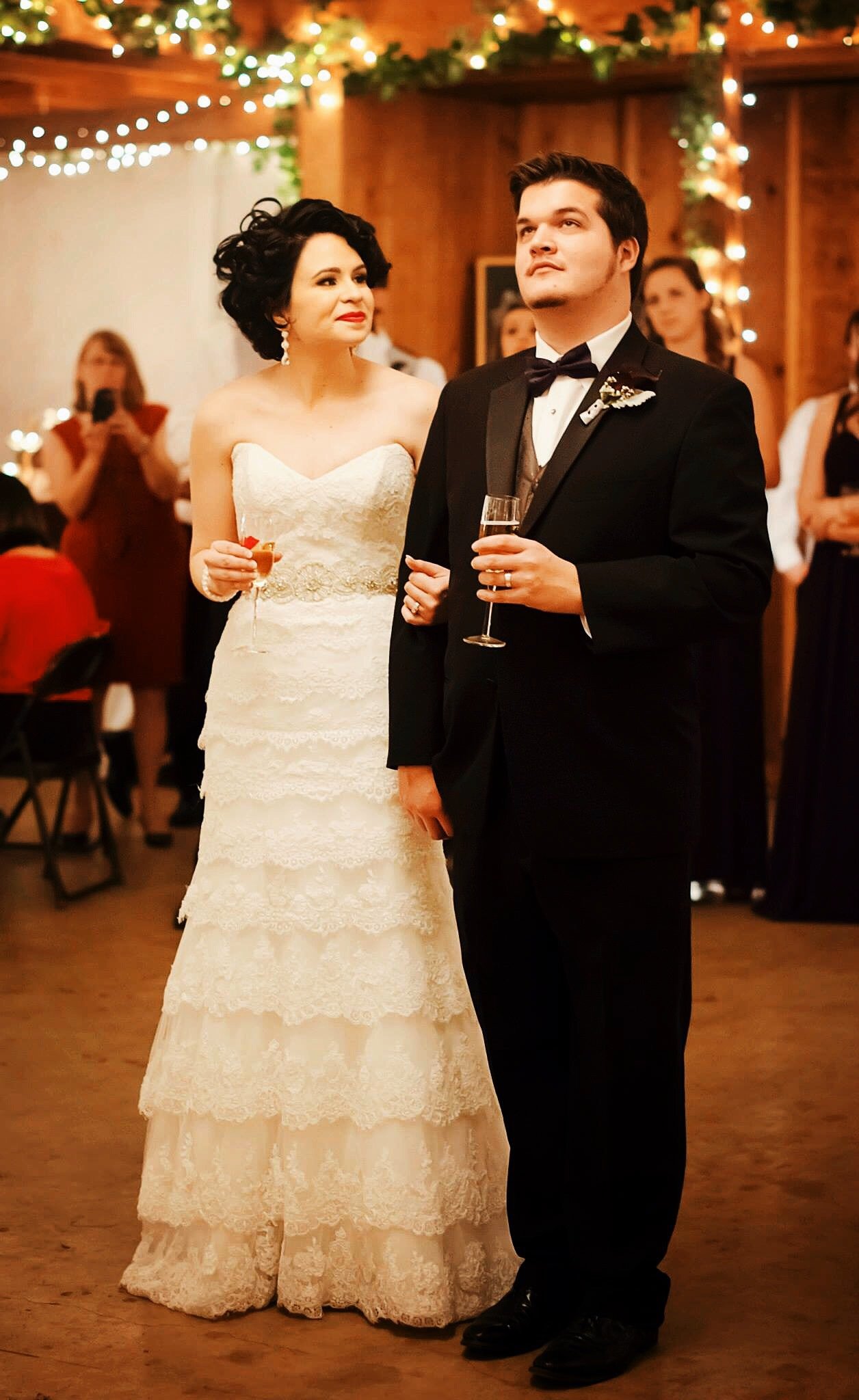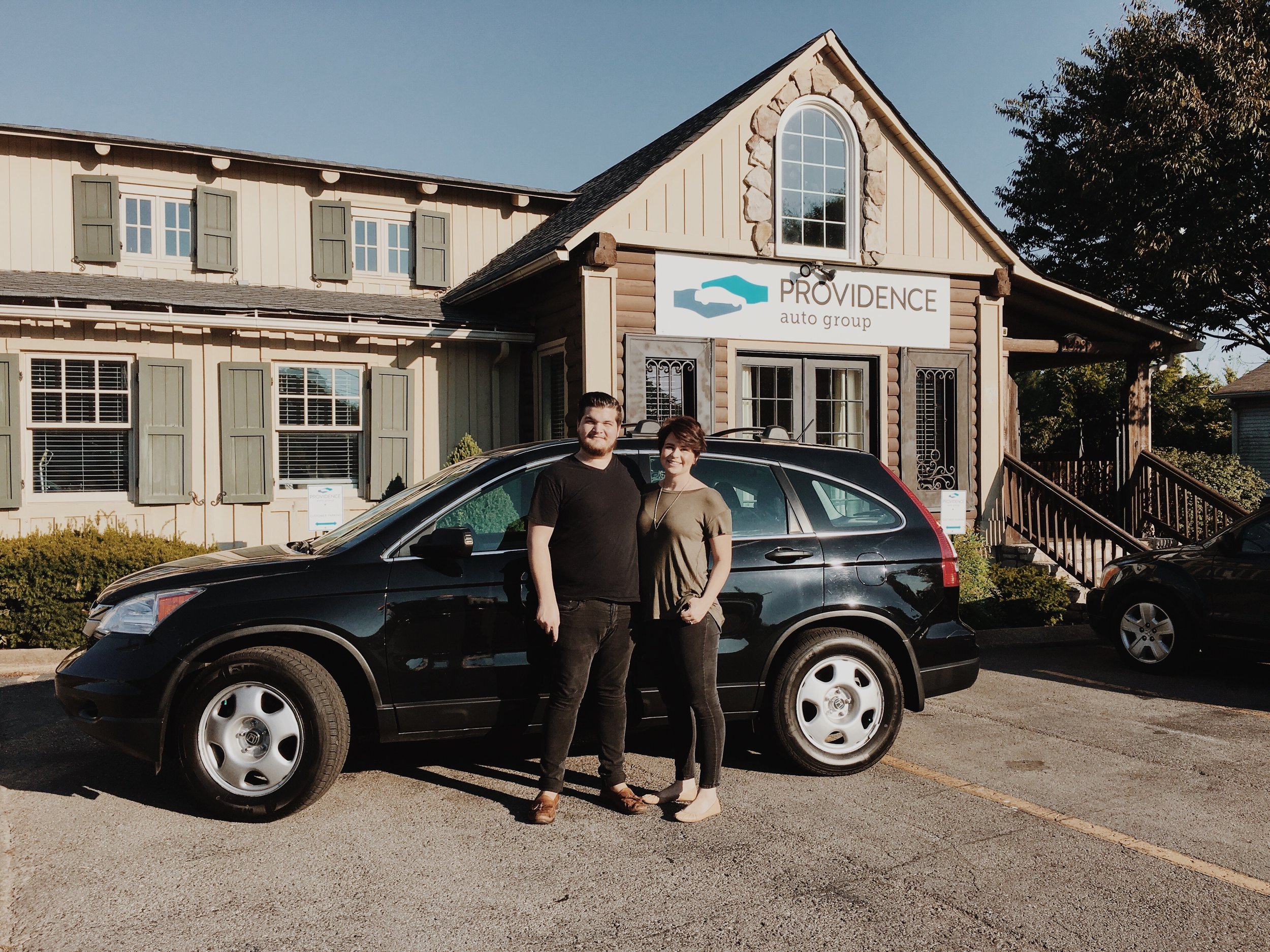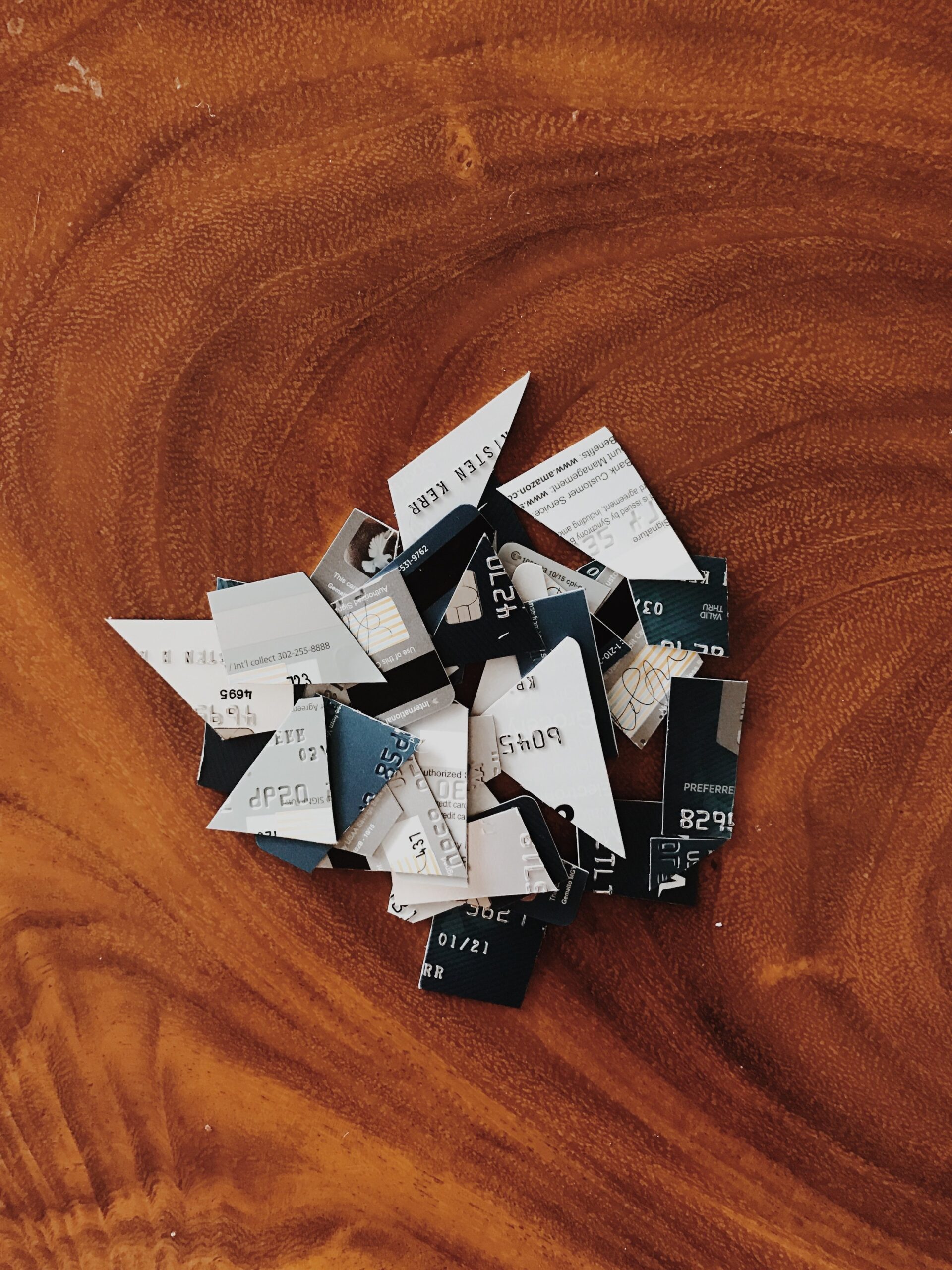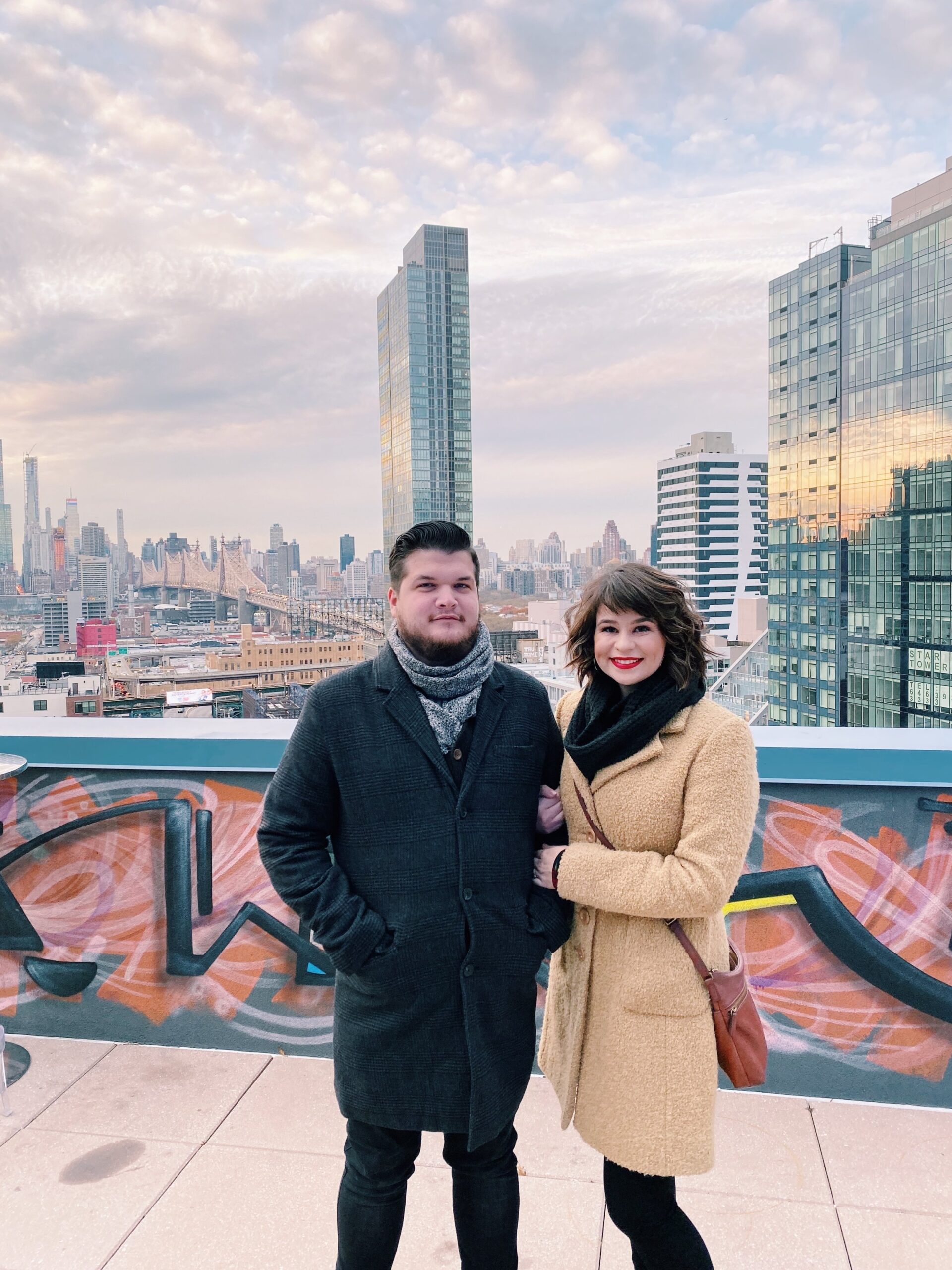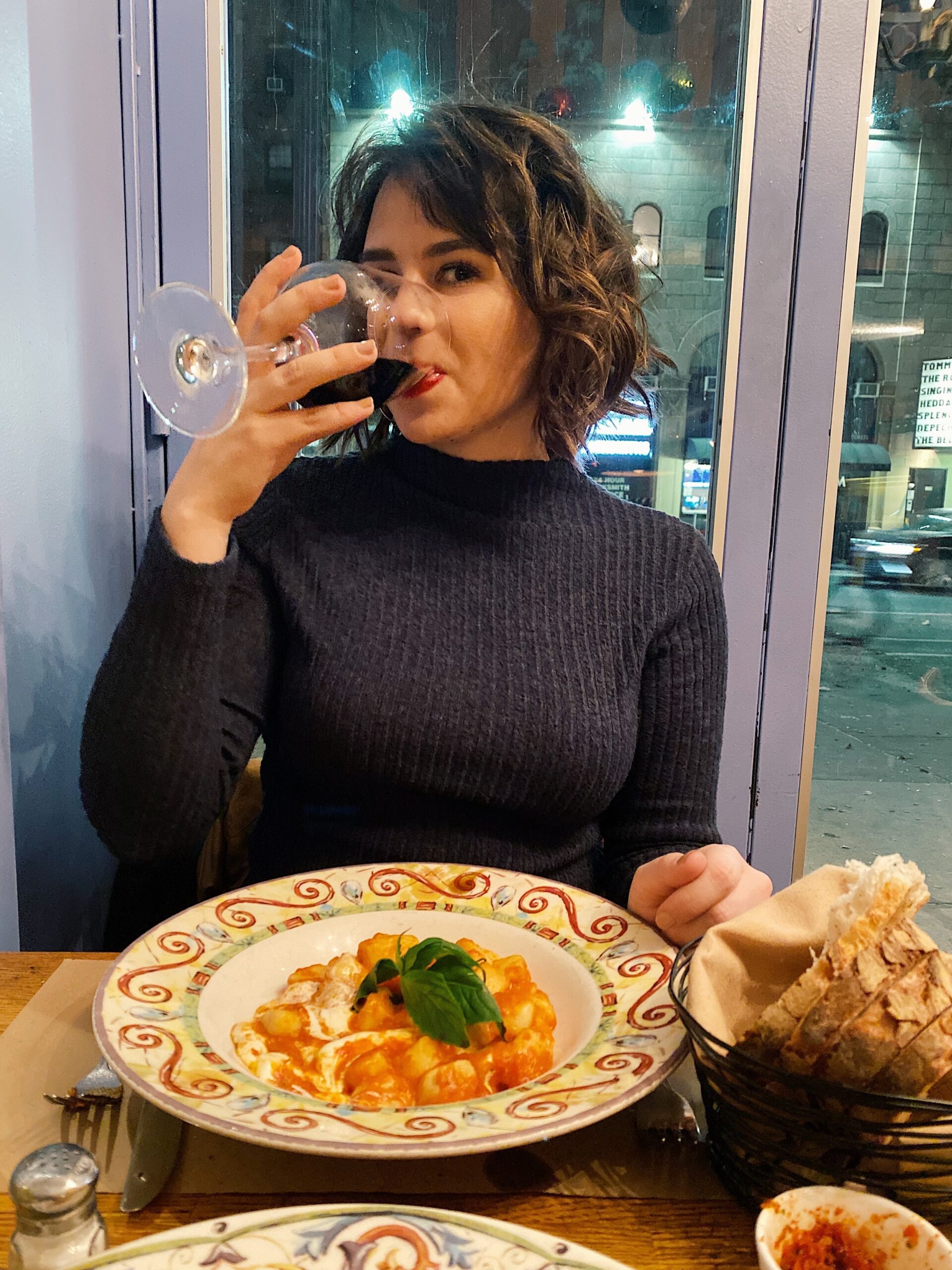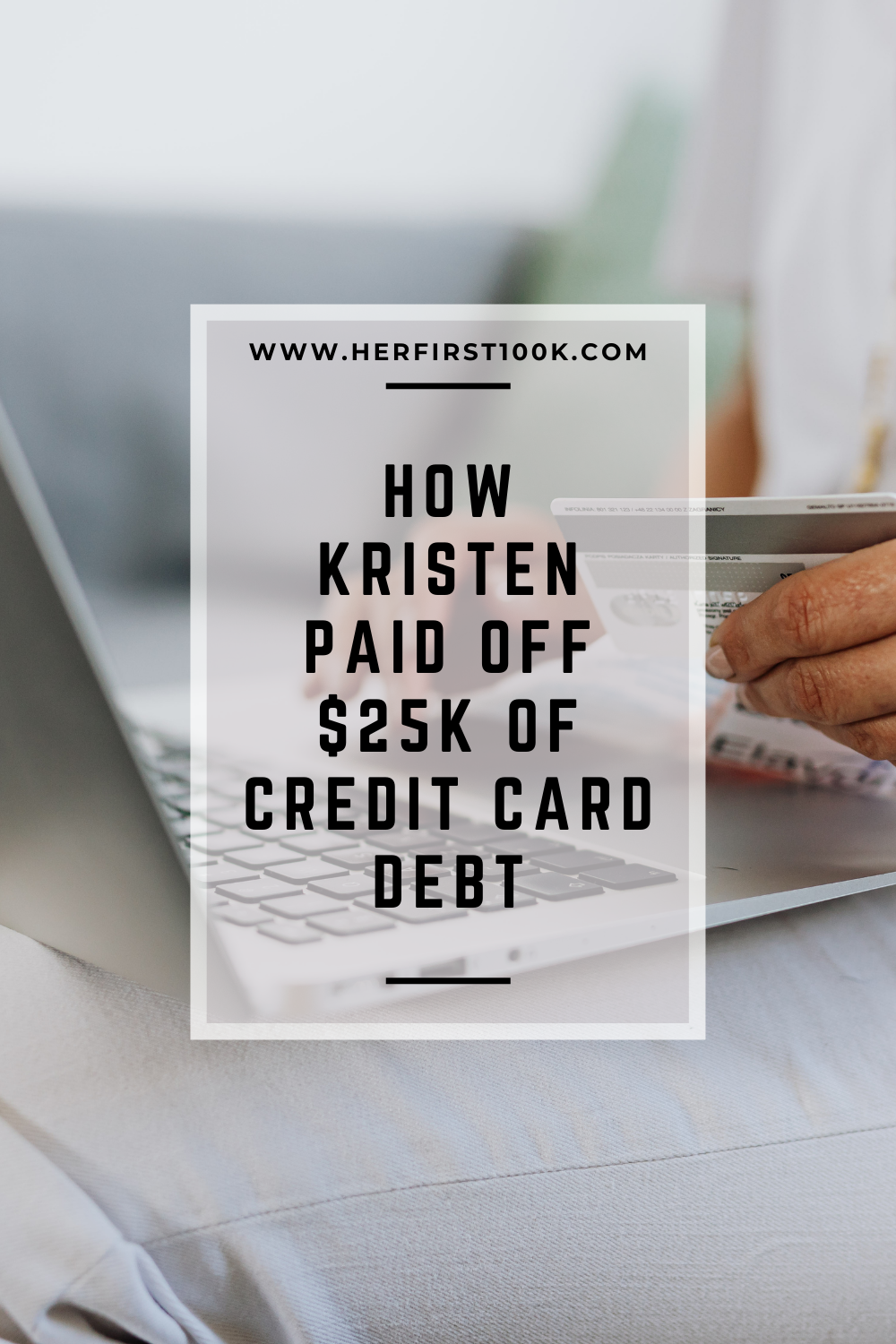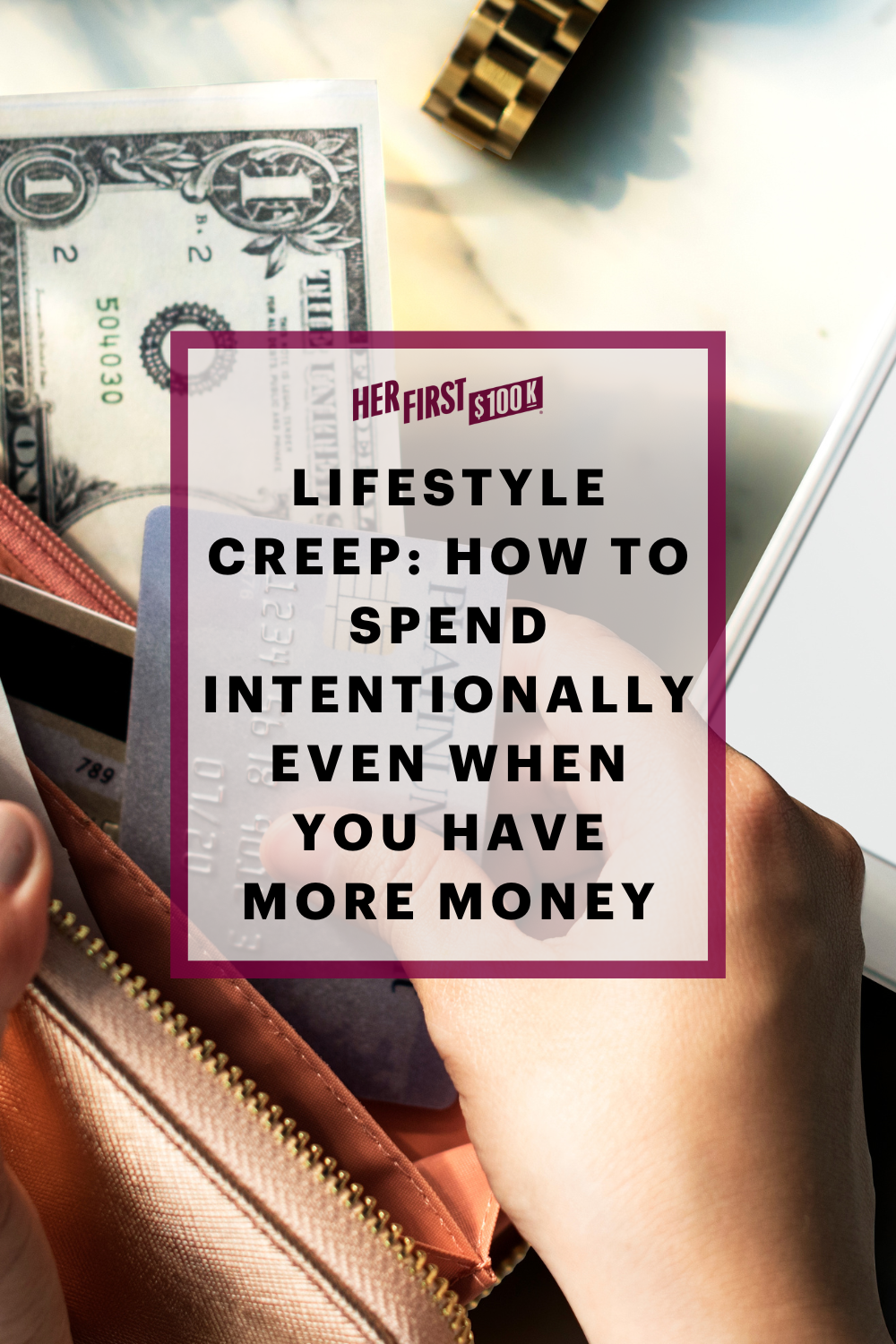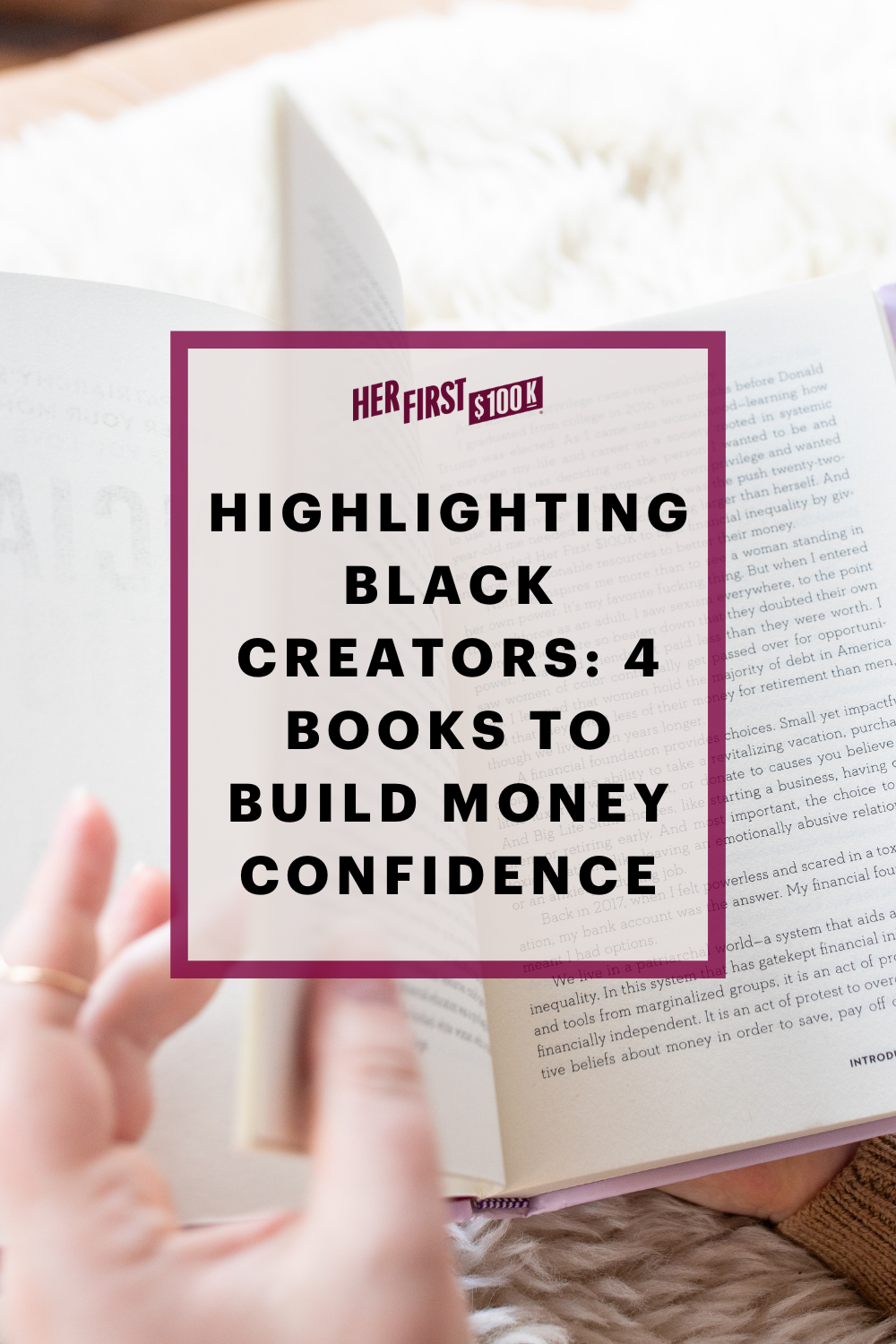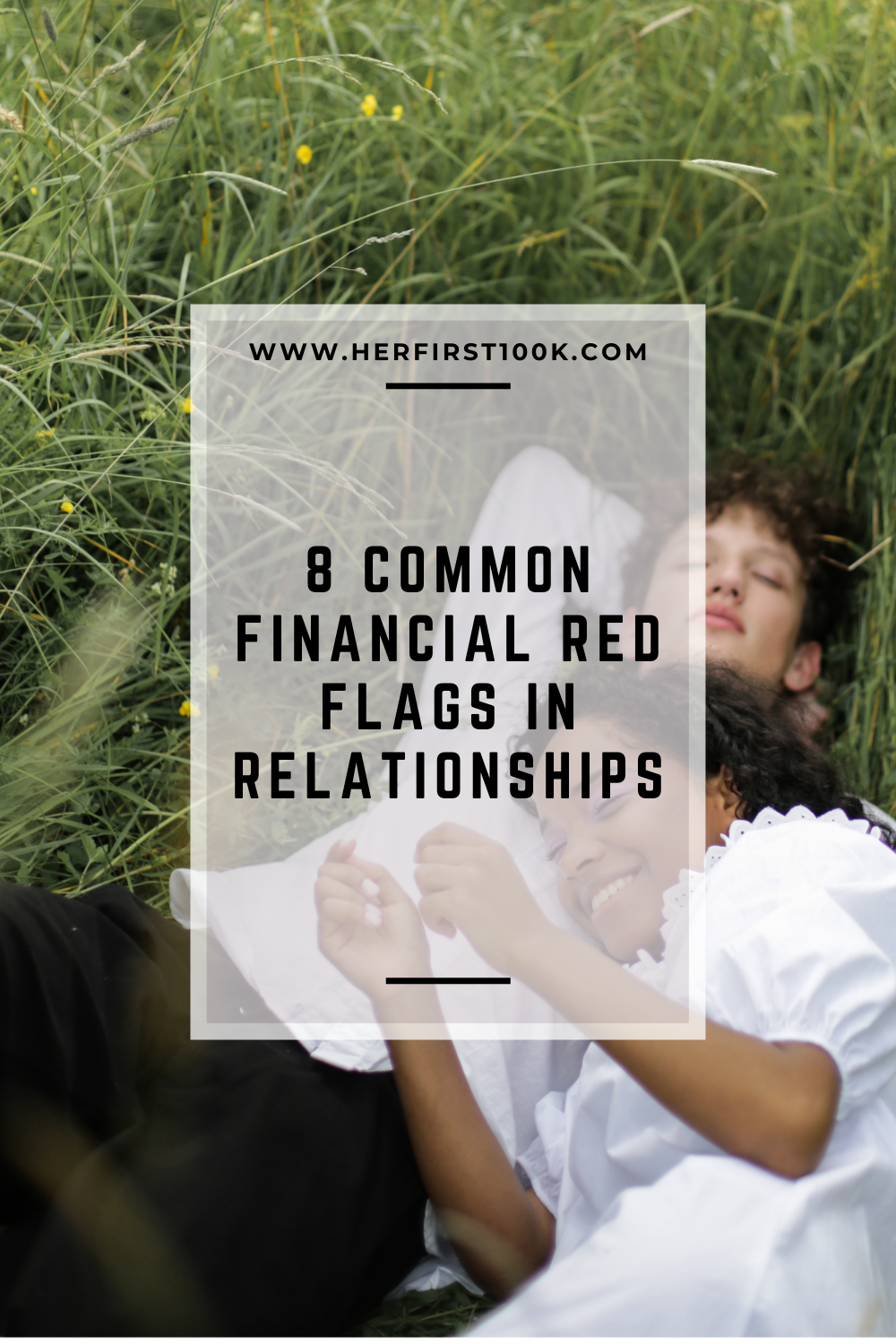The following article may contain affiliate links or sponsored content. This doesn’t cost you anything, and shopping or using our affiliate partners is a way to support our mission. I will never work with a brand or showcase a product that I don’t personally use or believe in.
How Kristen Paid off $25k of Credit Card Debt
The average American has over $90,000 in debt, and most people don’t have the resources or knowledge to navigate their debt payoff strategy in a way that truly works for their lifestyle while also actually minimizing their debt.
Why does debt payoff matter? Well, not only does carrying excessive debt cause financial strain and limit our economic future, but it also has emotional and even physical implications.
People who carry excessive debt are far more likely to experience depression, anxiety, and chronic illness than those who do not. And in a society where women make less money, have less invested in the stock market, and carry more overall debt than men, we are at a higher risk for experiencing debt-related health concerns.
So, today, I want to share the real-life debt payoff story of Kristin, an HFK community member, to dive into how debt was affecting her life, when she realized she needed to make a change, the steps she took to defeat her debt, and how paying off her debt gave her financial and personal freedom.
We were newlyweds, had just moved to a major city, were living paycheck to paycheck, and found ourselves $25,000 in debt with a letter from the IRS sitting on the kitchen counter. I remember asking myself, “How did we get here, and how the f*ck are we going to get out of this?”
Hi there! That’s me, Kristen, and my amazing husband, Austin.
I went to private school for elementary, and it was there that I first started to develop some sort of financial awareness. I realized that I didn’t have many of the same things that my peers had: backpacks with the newest characters on them, sparkly sneakers that definitely made you run faster, and the 30-pack of colorful gel pens that dried out after a single use.
I didn’t quite understand why I didn’t have those same things, but I was acutely aware that there was something that set my peers and I apart. I give my parents a lot of credit for this time –– they worked so hard to make sure I could go to a better school than what we were zoned for. Both of my parents took on extra work during my childhood, and I know that it was a sacrifice. But that also changed how I saw money –– as something you had to sacrifice to have.
That awareness continued to develop throughout my adolescence, and while I may not have known the ins and outs of my family’s finances, I could tell that there were times when we were doing okay, money-wise, and others when I could feel the tension that I came to associate with financial strain. Bear in mind, I was coming of age in the mid-2000s –– there was a lot of financial shit to feel stressed about.
But while our financial situation may have had its ups and downs, one thing that remained consistent was my family’s mindset about money:
In our home, money was discussed on a “need to know” basis – if it wasn’t essential for us kids to know, we wouldn’t.
I know this was my parent’s way of protecting us from the nitty gritty – but as a very empathic child, I always knew when things were tight. I grew an awareness out of this that made me more cautious around money. Some might even call it a bit of a fear of money.
We didn’t talk about budgeting or saving or setting financial goals beyond the basics of “you should save some of the money you make,” but not much additional guidance on why or how much.
When I got my first job at 16, I didn’t really know what to do with the money I was making. From my limited understanding of personal finance, I thought I was making pretty wise money decisions: I didn’t spend my money on big, flashy purchases, I shopped for items that were “practical”, and I navigated the sales rack like a pro.
I definitely was not proactively saving money from each paycheck, though. I knew to some extent that saving money was important, but without really understanding why and how to save, I wasn’t very motivated to do so.
So, despite the fact that I worked every summer between college classes, by the time I was graduating and in my early twenties, the most money I had ever saved was $500.
Post-college, I moved back in with my parents and started working full time, and did what any young, up-and-coming professional would do: opened my first credit card.
Things started off well – I paid my credit card off in full every month and never spent more than I had the cash to pay. Yet, I still wasn’t proactively saving any money, and I definitely didn’t have an emergency fund.
The day I married the love of my life.
Oh, and remember that “need to know basis” money mindset? Well, I carried that into my own family when I got married and relocated to a new city.
My husband and I were graciously given some money for our wedding, so with $3,000 to our names, we packed our bags and moved to Nashville.
We didn’t set a budget for the move – in fact, we didn’t set a budget for our lives together in general. After all, we were living in a new city and neither of us had jobs – kinda tough to create a budget around an unknown cost of living and a non-existent stream of income.
Austin and I are both creatives – he is an incredible musician and I am a performer and — at the time — a photographer. And while we both had the talent and the passion, it is no secret that it is challenging to “make it” in these industries, to say the least.
So while I worked to get my photography business off the ground and Austin continued to apply for jobs, I picked up a side gig waiting tables. Money was tight each month, and without any budget in place, we quickly learned what it meant to live paycheck to paycheck.
And then the inevitable happened: we had a few unexpected emergencies. One month we needed new tires. The next, the car broke down. After that, a surprise bill came in the mail and I accidentally used the wrong bank account to pay rent and got hit with a $100 returned check fee.
With no emergency fund in place and rent payments hanging over our heads, we had no choice but to charge these expenses to the credit card.
The day we bought a car with an interest rate that was WAY too high.
We started making minimum monthly credit card payments and watched what little extra money we had left after our essential living expenses disappear. We were barely making ends meet, and we were starting to feel the financial strain in our relationship that I was so wary of as a child.
Things came to a breaking point in 2016. I had managed to go full-time in my photography, Austin had steady employment, and we were finally making enough money to cover our living expenses and stay on top of our credit card bills. And by “on top” I really just mean making minimum payments.
I felt like I could see the light at the end of the tunnel – I remember thinking to myself, “If we can just keep this up, we will finally be able to get out of this debt.” And then, I got an overdraft alert from my credit card company.
You see, shortly after going full-time in my photography business, my absolute fossil of a laptop gave out on me. With no way to edit photos and make an income without a laptop, I decided to buy a new one with a credit card offering 0% interest for 18 months.
I figured 18 months would be plenty of time to pay off the cost of the laptop without ever having to worry about accumulating interest. But of course, life got in the way: there were a few months that I forgot to make payments, and those 18 months quickly went down to 12, and then 6, and then 1, and then 0. The balance of the laptop started to accumulate interest, and the amount of interest charged to the already-maxed-out credit card resulted in a $400 overdraft fee – $400 that we did not readily have.
I absolutely panicked and quickly scrounged together the $400 payment, only to realize that I had just missed the statement date. With no extra money and several maxed-out credit cards, I found another $400 bill in my inbox mere days after paying off the first.
And just when I thought things couldn’t get worse…alongside that credit card bill was a letter from the IRS.
With shaking hands and a pit in my stomach, I opened the letter. As it turned out, I hadn’t put enough aside for my business taxes and owed $4,000 in taxes for the year
I wanted to cry – where was I supposed to find an ADDITIONAL $4K to give to the IRS? My credit cards were maxed out, and there was no money left at the end of each month after our living expenses and minimum payments on our credit cards.
“This debt is going to ruin our lives.”
It was at this moment that I felt like everything came crashing down. There was no way that Austin and I could pay our monthly bills, pay off these credit cards, AND find extra money to throw at debt from the IRS. I knew we needed to make a change, and we needed to make it immediately.
Out of desperation, I turned to the low-cost financial program our church was offering to its congregation: Dave Ramsey’s Financial Peace University.
Listen, I’ll be the first to admit that Dave’s approach is not for everybody, and in hindsight, a lot of the money lessons we learned in the program were pretty toxic and damaging (and also old school as hell). But as two newlyweds who had accumulated thousands of dollars of debt and lacked basic financial literacy, FPU was the tool that kick-started our debt payoff journey. We ended up following baby steps 1 and 2, and now we see things a little differently after that.
The first step of our debt payoff journey was getting a thorough understanding of our debt.
We wrote down all of our debts, their balances, their interest rates, and their minimum payments. As someone who had avoided talking about money and had held an “ignorance is bliss” mindset for so long, this was an incredibly intimidating task. But once it was completed, Austin and I felt so liberated.
Being able to see an exact number of what we owed put everything into perspective and we could finally start to put together an actionable plan that was appropriate to our debt.
Then, we started an emergency fund.
In Financial Peace University, we were taught about the importance of an emergency fund and were encouraged to make saving $1,000 for our emergency fund our absolute financial priority.
We made the minimum payments on our credit cards to stay current and directed any extra money towards our emergency fund. It took us a whole year to hit our $1,000 goal, but reaching it was so motivating and also ensured that we wouldn’t reach for the credit cards if an emergency arose.
The next step in our debt payoff journey was creating a detailed and realistic budget.
For the first time ever, Austin and I wrote out exactly how much we were making and spending each month. We realized that in our attempt to “Keep up with the Joneses,” we had been living outside of our means, making it impossible to maintain our cost of living while also making any kind of significant progress on paying off our debts.
With this newfound understanding of our personal finances, we were able to create a budget that allowed for us to cover our essential living expenses and direct more money each month to paying off our debts.
The final step in our debt payoff journey was by far the hardest, but also the most important:
We created a debt payoff plan.
We decided to follow the “Debt Snowball” method for paying off our debt that we had learned about in FPU. In this strategy, you make minimum payments on all of your debts and direct any additional money towards paying off your smallest debt first. When the smallest debt is paid off, you redirect the money you were putting towards those payments towards your next smallest debt, and so on and so forth until your debt is paid.
The only problem? As it was, we didn’t have any “extra” income to throw at our smallest debt. So we both took on extra work and side hustles, the money from which automatically went to our debts.
And of course, since we were following Dave Ramsey’s teachings, we cut back on our spending…a lot. Dining out was a thing of the past. Shopping was reserved for absolute essentials only. Monthly subscriptions to Netflix and Spotify? Kissed them goodbye.
We were flexible and got comfortable with being uncomfortable.
The day we cut up our credit cards (we have more now, but we use them responsibly and pay them off immediately).
We quickly realized that the deprivation mindset taught by Financial Peace University was not going to be sustainable for us in the long term. Saying “no” to everything that we loved was making us feel bitter and resentful toward our debt payoff journey, and there were times when we wanted to give up on the process because we didn’t get to enjoy any of the things that we really loved.
It was at this point that we realized we wanted to take a different approach with our debt payoff journey than the one that we were offered through FPU. We wanted to find the balance between actively paying off our debts and spending money on things we enjoyed.
So once we settled into the groove of our Debt Snowball strategy, we actively incorporated a few “extras” into our budget that allowed us to continue to enjoy our lives while sticking to our budget and chipping away at our debts.
Additionally, we got really comfortable having uncomfortable conversations about money that we used to avoid.
As creatives, our income from month to month wasn’t always consistent, so we got in the habit of having monthly conversations about how much money we were bringing in, how much we were spending, how much progress we were making on our debt payoff journey, and what “extras” we wanted to incorporate into our month. Conversations that once were a source of shame and arguments became an opportunity for us to meet each other with grace and grow closer as partners.
Now, we didn’t do this perfectly. It took time and practice, and we ultimately needed to ask for help. We found a counseling center in our area that offered sliding scale pricing so that we could afford sessions and learn how to communicate better with one another – and we were so thankful that we had the flexibility in our budget to incorporate these sessions into our monthly expenses.
After two and a half years of using the Debt Snowball method, we were able to successfully pay off $25,000 in debt.
It wasn’t easy. I remember feeling so envious watching my friends buy homes and taking lavish vacations while Austin and I treated ourselves to dinner at a restaurant once a month. I will never forget how it felt to say “I’m sorry, I can’t be a bridesmaid at your destination wedding – it’s not in my budget.”
And I can hardly describe how frustrated I was when, after spending a year saving our $1,000 emergency fund, we had to spend every penny of it on unexpected car repairs and start over.
But I will also never forget the peace I felt knowing that I had an emergency fund to fall back on and didn’t have to put the repairs on a credit card. Austin and I still talk about the thrill we felt when we physically cut up a credit card after we finally paid it off. We went on a vacation together and paid cash for the whole trip when just a few years ago we couldn’t afford to drive home and visit family for the holidays.
We spent a few days in New York City and paid for the entire trip in cash.
We were both so proud that we were able to leave a hefty tip after this meal.
Looking back on our debt payoff journey, all the sacrifices made sense and were so worth the freedom we now have.
I discovered Her First $100K just as we were paying off our last credit card.
As we got closer to paying off our credit card debt, I started to panic. I had gotten so comfortable with a “pay off my debt at all costs” mindset that I worried that without the cloud of debt hanging over my head, I would fall back into old spending habits.
The resources and information I received through HFK helped me not only push through the final leg of my debt payoff journey but also helped Austin and me set new financial goals and create an actionable plan to reach those goals.
We use a spreadsheet to track our income and spending, and we have both become incredibly confident in negotiating our salaries and bills (check out this episode on negotiation!). We have also officially saved 3 months’ worth of expenses for our emergency fund, and we even started investing with Stock Market School.
One of the ways that we both have most benefited from HFK is by receiving permission to release the shame we felt about our debt.
As we worked our way through Financial Peace University, we were taught that all debt is bad debt and that we were essentially bad people for falling into debt. We were made to feel like we had done something wrong by taking out student loans and accumulating debt due to unforeseen circumstances. Even after we had paid off the majority of our debt, the shame continued to hang over our heads like a cloud that we couldn’t escape.
Her First $100K helped us realize that having debt is normal and that it’s not our fault that we didn’t receive the financial education we needed in order to successfully navigate this country’s debt and credit system.
Now, I have developed a healthy relationship with credit cards. I prioritize saving for retirement and investing in the stock market. I have a budget that truly aligns with my values and goals for the future.
For the first time in my life, I feel confident and capable in my finances, and I am excited for a future where I am in control of my debt, and not the other way around.
Ready to embark on a debt payoff journey of your own? You don’t have to do it alone.
Our newest course and online community, The 100K Club, will give you the context, information, and actionable steps you need in order to pay off your debt, free yourself from debt-related shame, and heal your relationship with credit.

